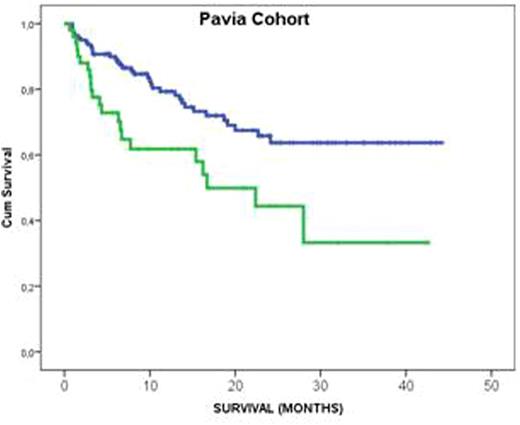Abstract
Growth differentiation factor-15 (GDF-15), a member of TGF-beta family, is involved in several pathological conditions, which include inflammation, cancer, cardiovascular, pulmonary and renal diseases. Serum GDF-15 levels add prognostic information to conventional prognostic factors, such as NT-proBNP and troponins, in cardiovascular disorders and also have shown to be associated with renal damage and risk of end stage renal disease in patients with diabetes. Based on the above data, we evaluated the prognostic value of GDF-15 levels in patients with AL amyloidosis and showed that in a cohort of 77 patients GDF-15 was associated with early death, shorter survival and progression to dialysis, independently of the cardiac biomarkers and renal stage. In order to validate the prognostic value of serum levels of GDF-15, we evaluated GDF-15 in two independent cohorts of patients treated in two different centers (Pavia Amyloidosis Center and Department of Clinical Therapeutics, Athens).
Circulating levels of GDF-15 were measured by a novel pre-commercial immunoassay (Roche Diagnostics) in stored serum. The Pavia cohort included 202 and the Athens cohort included 107 patients with AL amyloidosis. Standard criteria were used for the diagnosis, evaluation of organ involvement and cardiobiomarker-based risk stratification. Renal staging was based on the system proposed by Palladini et al, based on baseline proteinuria >5 gr/day and eGFR <50 ml/min.
Median age and involved FC (iFLC) levels were similar between the two cohorts but there were differences in other baseline characteristics including heart involvement (77% vs 62% for Pavia vs Athens, p=0.007), Mayo stage (15%, 43% & 42% for stage 1, 2 & 3 in Pavia cohort, vs 26%, 43% & 31% in Athens cohort, p=0.04, but stage 3B was similar, 22% vs 24%). Also there were differences in peripheral nerve involvement (11% in Pavia vs 25% in Athens cohort, p=0.001). Renal involvement (67% vs 72%, p=0.415), median eGFR and renal stage distribution were similar between the two cohorts (p=0.544). Median follow up for the Pavia cohort was 18 months and for the Athens cohort was 45 months (p<0.001). Survival at 2 years was 59% for Pavia and 56% for Athens cohort.
Median GDF-15 levels was 3027 pg/ml in Pavia (range 624 to >100000 pg/ml) and 3854 pg/ml (range 626-71475 pg/ml) in Athens cohort (p=0.09); the upper quartile of GDF-15 levels however was ≥5658 pg/ml for the Pavia and ≥7553 pg/ml for Athens cohort, while 90% and 94% of patients in the two cohorts had GDF-15 levels >1200 pg/ml (the upper limit of normal for individuals without cardiovascular disease).
We then evaluated the prognostic significance of GDF-15 levels in the two cohorts by applying the previously identified cutoff of 7575 pg/ml. GDF-15 above cutoff was associated with significantly shorter survival both in Pavia (17 months vs not reached, p=0.003) and in Athens cohort (13 vs 47 months, p=0.03) (Figure 1). A multivariate model that included Mayo stage, separately for each cohort was applied. In both cohorts GDF-15 retained independent prognostic significance over Mayo stage, having a hazard ratio (HR) of 1.9 (95% CI 1.2-3.3, p=0.01) in Pavia cohort (the respective HRs for Mayo stage -2 vs -1 was 2.1 and for stage -3 vs stage -1 was 4); in Athens cohort HR for GDF-15 was 1.8 (95% CI 1.2-3.6, p=0.03) and the respective HRs for Mayo stage -2 vs -1 was 5.3 and for stage 3- vs stage -1 was 6.8.
We then evaluated the prognostic significance regarding renal outcomes (dialysis): GDF-15 >4000 pg/ml was associated with a HR of 6 (95% CI 2015.6, p=0.001) in Athens cohort (progression to dialysis within 2 years in 7% vs 47%); however, very few events have occurred in Pavia cohort and analysis was inconclusive. Although renal stage discriminated 3 groups in univariate analysis (p=0.03), in multivariate analysis, GDF-15 >4000 pg/ml outperformed renal stage and was the only independent prognostic factor for dialysis risk.
In conclusion, our study validated and confirmed in two independent cohorts, with differences in their characteristics, the prognostic value of GDF-15, which emerges as a novel biomarker with prognostic implications for different outcomes in patients with AL amyloidosis. Importantly, GDF-15 emerges also as new biomarkers for renal outcomes in patients with AL amyloidosis.
Kastritis:Janssen: Consultancy, Honoraria; Amgen: Consultancy, Honoraria; Takeda: Consultancy, Honoraria; Genesis: Consultancy, Honoraria. Merlini:Takeda and Janssen-Cilag: Honoraria. Terpos:Genesis: Consultancy, Honoraria, Other: Travel expenses; Janssen: Consultancy, Honoraria, Other: Travel expenses, Research Funding; Celgene: Honoraria; Takeda: Consultancy, Honoraria; BMS: Consultancy, Honoraria; Amgen: Consultancy, Honoraria, Other: Travel expenses, Research Funding; Novartis: Honoraria. Dimopoulos:Janssen: Consultancy, Honoraria, Membership on an entity's Board of Directors or advisory committees; Genesis: Consultancy, Honoraria; Amgen: Consultancy, Honoraria, Membership on an entity's Board of Directors or advisory committees; Celgene: Consultancy, Honoraria, Membership on an entity's Board of Directors or advisory committees; Novartis: Consultancy, Honoraria, Membership on an entity's Board of Directors or advisory committees. Palladini:Prothena: Honoraria.
Author notes
Asterisk with author names denotes non-ASH members.



This feature is available to Subscribers Only
Sign In or Create an Account Close Modal